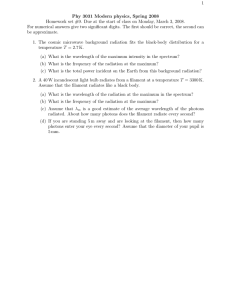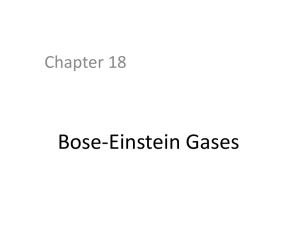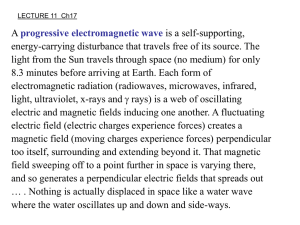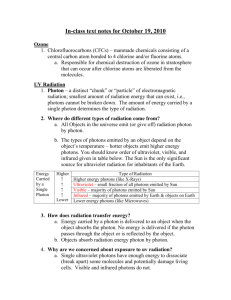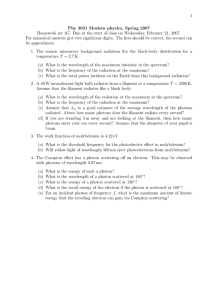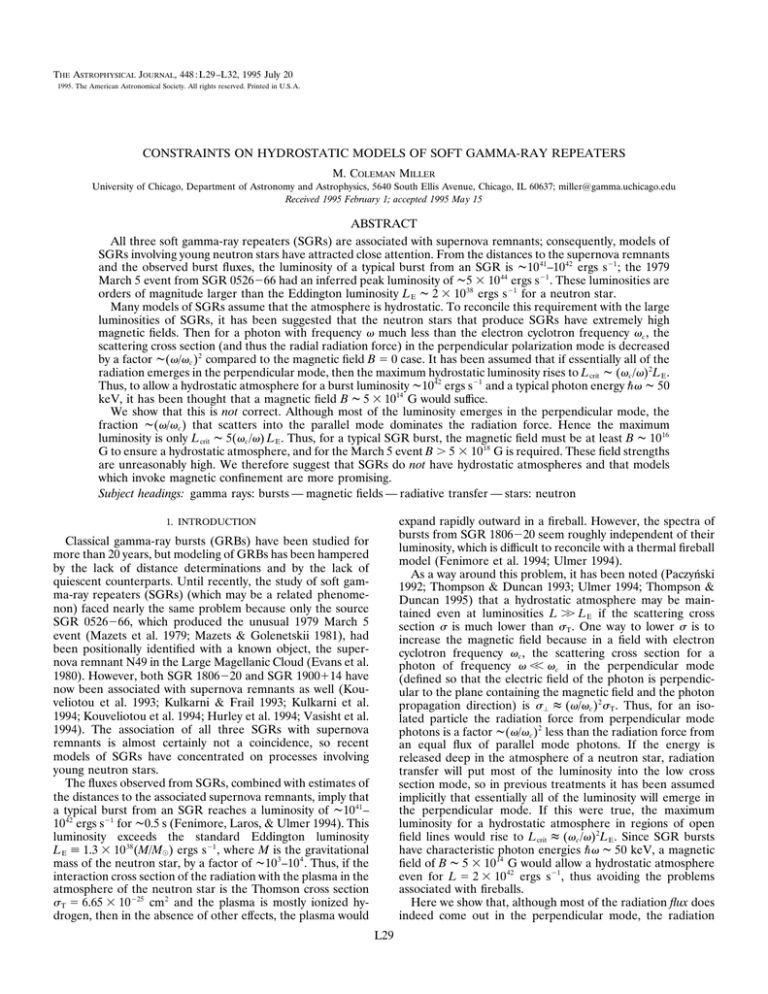
THE ASTROPHYSICAL JOURNAL, 448 : L29 –L32, 1995 July 20
1995. The American Astronomical Society. All rights reserved. Printed in U.S.A.
CONSTRAINTS ON HYDROSTATIC MODELS OF SOFT GAMMA-RAY REPEATERS
M. COLEMAN MILLER
University of Chicago, Department of Astronomy and Astrophysics, 5640 South Ellis Avenue, Chicago, IL 60637; miller@gamma.uchicago.edu
Received 1995 February 1; accepted 1995 May 15
ABSTRACT
All three soft gamma-ray repeaters (SGRs) are associated with supernova remnants; consequently, models of
SGRs involving young neutron stars have attracted close attention. From the distances to the supernova remnants
and the observed burst fluxes, the luminosity of a typical burst from an SGR is 110 41 –10 42 ergs s 21 ; the 1979
March 5 event from SGR 0526266 had an inferred peak luminosity of 15 3 10 44 ergs s 21 . These luminosities are
orders of magnitude larger than the Eddington luminosity L E 1 2 3 10 38 ergs s 21 for a neutron star.
Many models of SGRs assume that the atmosphere is hydrostatic. To reconcile this requirement with the large
luminosities of SGRs, it has been suggested that the neutron stars that produce SGRs have extremely high
magnetic fields. Then for a photon with frequency v much less than the electron cyclotron frequency v c , the
scattering cross section (and thus the radial radiation force) in the perpendicular polarization mode is decreased
by a factor 1(v/v c ) 2 compared to the magnetic field B 5 0 case. It has been assumed that if essentially all of the
radiation emerges in the perpendicular mode, then the maximum hydrostatic luminosity rises to L crit 1 (v c /v) 2 L E .
Thus, to allow a hydrostatic atmosphere for a burst luminosity 110 42 ergs s 21 and a typical photon energy \v 1 50
keV, it has been thought that a magnetic field B 1 5 3 1014 G would suffice.
We show that this is not correct. Although most of the luminosity emerges in the perpendicular mode, the
fraction 1(v/v c ) that scatters into the parallel mode dominates the radiation force. Hence the maximum
luminosity is only L crit 1 5(v c /v) L E . Thus, for a typical SGR burst, the magnetic field must be at least B 1 10 16
G to ensure a hydrostatic atmosphere, and for the March 5 event B . 5 3 10 18 G is required. These field strengths
are unreasonably high. We therefore suggest that SGRs do not have hydrostatic atmospheres and that models
which invoke magnetic confinement are more promising.
Subject headings: gamma rays: bursts — magnetic fields — radiative transfer — stars: neutron
expand rapidly outward in a fireball. However, the spectra of
bursts from SGR 1806220 seem roughly independent of their
luminosity, which is difficult to reconcile with a thermal fireball
model (Fenimore et al. 1994; Ulmer 1994).
As a way around this problem, it has been noted (Paczyński
1992; Thompson & Duncan 1993; Ulmer 1994; Thompson &
Duncan 1995) that a hydrostatic atmosphere may be maintained even at luminosities L .. L E if the scattering cross
section s is much lower than s T . One way to lower s is to
increase the magnetic field because in a field with electron
cyclotron frequency v c , the scattering cross section for a
photon of frequency v ,, v c in the perpendicular mode
(defined so that the electric field of the photon is perpendicular to the plane containing the magnetic field and the photon
propagation direction) is s ' 2 (v/v c ) 2 s T . Thus, for an isolated particle the radiation force from perpendicular mode
photons is a factor 1(v/v c ) 2 less than the radiation force from
an equal flux of parallel mode photons. If the energy is
released deep in the atmosphere of a neutron star, radiation
transfer will put most of the luminosity into the low cross
section mode, so in previous treatments it has been assumed
implicitly that essentially all of the luminosity will emerge in
the perpendicular mode. If this were true, the maximum
luminosity for a hydrostatic atmosphere in regions of open
field lines would rise to L crit 2 (v c /v) 2 L E . Since SGR bursts
have characteristic photon energies \v 1 50 keV, a magnetic
field of B 1 5 3 10 14 G would allow a hydrostatic atmosphere
even for L 5 2 3 10 42 ergs s 21 , thus avoiding the problems
associated with fireballs.
Here we show that, although most of the radiation flux does
indeed come out in the perpendicular mode, the radiation
1. INTRODUCTION
Classical gamma-ray bursts (GRBs) have been studied for
more than 20 years, but modeling of GRBs has been hampered
by the lack of distance determinations and by the lack of
quiescent counterparts. Until recently, the study of soft gamma-ray repeaters (SGRs) (which may be a related phenomenon) faced nearly the same problem because only the source
SGR 0526266, which produced the unusual 1979 March 5
event (Mazets et al. 1979; Mazets & Golenetskii 1981), had
been positionally identified with a known object, the supernova remnant N49 in the Large Magellanic Cloud (Evans et al.
1980). However, both SGR 1806220 and SGR 1900114 have
now been associated with supernova remnants as well (Kouveliotou et al. 1993; Kulkarni & Frail 1993; Kulkarni et al.
1994; Kouveliotou et al. 1994; Hurley et al. 1994; Vasisht et al.
1994). The association of all three SGRs with supernova
remnants is almost certainly not a coincidence, so recent
models of SGRs have concentrated on processes involving
young neutron stars.
The fluxes observed from SGRs, combined with estimates of
the distances to the associated supernova remnants, imply that
a typical burst from an SGR reaches a luminosity of 110 41 –
10 42 ergs s 21 for 10.5 s (Fenimore, Laros, & Ulmer 1994). This
luminosity exceeds the standard Eddington luminosity
L E [ 1.3 3 10 38 (M/M J ) ergs s 21 , where M is the gravitational
mass of the neutron star, by a factor of 110 3 –10 4 . Thus, if the
interaction cross section of the radiation with the plasma in the
atmosphere of the neutron star is the Thomson cross section
s T 5 6.65 3 10 225 cm 2 and the plasma is mostly ionized hydrogen, then in the absence of other effects, the plasma would
L29
L30
MILLER
FIG. 1.—Schematic diagram of photon propagation through an atmosphere.
A total luminosity L tot is released deep in the atmosphere at a perpendicular
optical depth t ' .. 1. It then scatters many times, occasionally changing
polarization, until it finally escapes. The sample photon represented in this
figure converted from perpendicular to parallel at t i , (v c /v) and was still in
the parallel mode when it escaped.
force is dominated by parallel mode photons, which have a
scattering cross section s i 1 s T . As we show to order of
magnitude in § 2 and in detail with numerical simulations in
§ 3, this occurs because a fraction 10.2(v/v c ) of the perpendicular mode photons convert into the parallel mode and then
escape while still in the parallel mode. Therefore, the maximum
luminosity is not Lcrit 1 (vc /v)2 LE but, rather, Lcrit = 5(vc /v) LE .
Thus, for example, the magnetic field required for a hydrostatic
atmosphere with 50 keV photons at 1042 ergs s21 is not 5 3 1014
G but, rather, B ? 1016 G. For the March 5 event, which reached
a peak luminosity of 15 3 1044 ergs s21 , a magnetic field
B ? 5 3 1018 G would be needed. Moreover, although throughout this Letter we make the conservative assumption that the
radiation interacts with the matter via scattering only, bound-free
absorption and other processes may significantly increase the
radiation force (Miller & Bulik 1995). The true minimum magnetic fields for hydrostatic atmospheres in regions of open field
lines are thus even greater than estimated here. Such magnetic
fields are improbable, and in § 4 we suggest instead that magnetic
confinement, which may be accomplished with much more
modest field strengths, is a more promising avenue to explore.
2. ORDER OF MAGNITUDE TREATMENT
Before we perform a detailed calculation, we can derive the
rough dependence of the critical luminosity on the magnetic
field by an order of magnitude estimate. Consider the physical
picture shown in Figure 1. In this picture, a total luminosity
L tot is released somewhere deep in the atmosphere, and the
photons then propagate upward by scattering. The photons
can be divided into two classes, depending on their polarization: either their electric field vector is in the plane of the
magnetic field and the photon propagation direction (i) or the
electric field vector is perpendicular to that plane ('). In the
limit v ,, v c , where the photon frequency is much less than
the electron cyclotron frequency, if \v ,, m e c 2 then in a
Vol. 448
vacuum the scattering cross sections for the two modes are
s i 1 s T and s ' 1 (v/v c ) 2 s T . In an individual scattering there
is a chance that the polarization mode may switch, and the
probabilities are (see Herold 1979) P(i 3 ') 1 (v/v c ) 2 and
P(' 3 i) 5 1/4.
Now consider the propagation of the radiation from an
initial perpendicular optical depth t ' .. 1. When t ' .. 1,
detailed balance guarantees that the number density of perpendicular mode photons is equal to the number density of
parallel mode photons. At these high optical depths, most of
the flux is transported in the perpendicular mode, but the
radiation forces for the two modes are equal to each other.
When the radiation gets to t ' 1 1, a significant number of
perpendicular mode photons can escape from the atmosphere
without scattering, but because at that point the parallel
optical depth is t i 1 (v c /v) 2 .. 1, the parallel mode photons
are trapped, and most of them eventually scatter into the
perpendicular mode. Thus, the fraction of perpendicular mode
photons increases with decreasing optical depth, and ultimately the observed photons are almost all in the perpendicular mode.
However, although the escaping luminosit y is dominated by
the perpendicular mode photons, the radiation f orce on a test
particle at t i 5 t ' 5 0 is dominated by parallel mode photons.
To see this, consider the atmosphere at t ' 5 v/v c (so that
t i 5 v c /v). Assume that all the photons are in the perpendicular mode. A fraction 1v/v c of those photons will scatter
before they reach the surface, and one-fourth of the photons
that scatter will switch into the parallel mode. Because t i 5 v c /
v, the newly created parallel photons will scatter 1(v2 c /v) 2
times before escaping, and a fraction 1[1 2 (v/v c ) 2 ] (v c /v) 1 1/
e of those photons will escape while still in the parallel mode.
Thus, the luminosity in the parallel mode is approximately
Li 1
11
~ v / v c ! L tot 1 0.1~ v / v c ! L tot .
e4
(1)
Since s i 2 s T , the requirement of a hydrostatic atmosphere
implies L i , L E , or
L tot = 10~ v c / v ! L E .
(2)
The more detailed calculations presented below show that the
coefficient is actually 5, not 10.
3. NUMERICAL RESULTS
To estimate more precisely the total radiation force, we
performed numerical simulations of photons propagating
through a neutron star atmosphere. In these simulations we
assumed that the photons interacted via scattering only and
that the energy of the photons was unchanged by the scattering. We started each photon in the perpendicular mode at
t ' 5 3 and followed until it escaped from the atmosphere, and
we assumed that the magnetic field direction was parallel to
the surface normal. We then computed the radiation force and
radial radiation flux for each photon and determined the total
force per unit flux.
For each scattering, we calculated the direction of scattering, mean free path, and polarization using the differential
cross section derived by Herold (1979), which is valid for low
plasma density when \v ,, m e c 2 and \v ,, \v c :
ds
1
5 r 2 ua~s 3 s9!u 2
dV9 4 0
(3)
No. 1, 1995
SOFT GAMMA-RAY REPEATERS
L31
with
a~i 3 i! 5 2 sin u sin u9
S
1 cos u cos u9 e i~f2f9!
a~' 3 '! 5 e i~f2f9!
S
v
v
2 e 2i~f2f9!
,
vc
vc
a~i 3 '! 5 2i cos u e i~f2f9!
and
D
v
v
2 e 2i~f2f9!
,
vc
vc
S
a~' 3 i! 5 i cos u9 e i~f2f9!
D
v
v
1 e 2i~f2f9!
,
vc
vc
D
v
v
1 e 2i~f2f9!
,
vc
vc
(4)
where u and u9 are, respectively, the initial and final photon
propagation directions with respect to the magnetic field; f
and f9 are the initial and final azimuthal directions; V9 is the
element of solid angle into which the photon is scattering; s
and s9 are the initial and final polarization states; and
r 0 5 2.8 3 10 213 cm is the classical radius of the electron. If the
plasma is dense enough to significantly affect the dielectric
tensor, the scattering cross section, and thus the radiation
force, is greater than assumed here (see, e.g., Mészáros 1992,
p. 89ff).
Since we are ultimately interested in the critical luminosity
such that the radial radiation force balances the gravitational
force, we need to calculate the radial radiation force for a
given radial flux. This force is often assumed to be proportional to the gradient of the radiation pressure. However,
f ò ¹P r if the opacity depends on either the frequency or the
incident direction of the photon or if the photon mean free
path is large compared to other relevant length scales (Lamb
& Miller 1995); for example, a laser beam in a vacuum exerts
a radiation force although the pressure gradient along the
beam is negligible. Thus, the radiation force at t ,, 1 must be
calculated with a more general formula.
r̂
From Lamb & Miller (1995), the radial radiation force f rad
on a particle at position x g due to a radiation field with specific
intensity I(n, n; x g ) (where n and n are the direction and
frequency of the radiation) is
f r̂rad 5
1
c
E E
E
dn
E E
E
s r̂ ~n, n ! 5
(5)
4p
0
where
dV I~n, n ; x g ! s r̂ ~n, n !,
dn9
dV9
4p
0
ds
~n, n ; n9, n 9!n r̂ .
dV9
(6)
is the cross section for momentum transfer in the radial
direction and the radiation is assumed to scatter into a solid
angle dV9 around the direction n9. Equation (6) assumes that
the photon frequency is unchanged by the scattering and that
the differential cross section is symmetric about the radial
direction (because we have assumed that the magnetic field is
in the radial direction). Similarly, the radial flux at x g is
E E
E
F~n r̂ ; x g ! 5 c
dn
0
4p
dV I~n, n ; x g !n r̂
(7)
FIG. 2.—Radial force per flux vs. v c /v, the electron cyclotron frequency
r̂
divided by the photon frequency. The ratio f rad
/F(n r̂ ) is multiplied by v c /v to
r̂
r̂
demonstrate the scaling f rad
1 (v/v c ). The statistical error in [ f rad
/F(n r̂ )](v c /v)
is 20.02 in each case.
(Lamb & Miller 1995). In the numerical calculations the
integrals are replaced by sums over the incident photons. In
our case, a photon emerging at an angle u with respect to the
magnetic field contributes a radial flux proportional to cos u
and a radial force proportional to sin 2 u cos u if the photon is
in the parallel mode versus a radial radiation force 1(v/v c ) 2
cos u if the photon is in the perpendicular mode. Note,
however, that the expressions for the radial radiation force are
more complicated for arbitrary magnetic field orientations. To
estimate the force for a given flux, we propagated 50,000 –
100,000 photons through the atmosphere (depending on the
value of v c /v), got the total radial flux and total radial
radiation force, and divided the force by the flux. To make the
code more efficient, we assumed that photons at t ' . 3
remained in the perpendicular mode. This is physically justified because the distance traveled in the parallel mode at that
depth is negligible, and this approximation makes less than a
1% difference in the results presented here.
Figure 2 shows the results of these calculations for
v c /v 5 10 –100, where we plot the force divided by the flux,
r̂
/F(n r̂ ), multiplied by v c /v, against v c /v. For v c /v .. 1,
f rad
r̂
[ f rad/F(n r̂ )](v c /v) approaches 10.2 asymptotically. Thus, as
indicated by the order-of-magnitude estimate, for v c /v .. 1
the radiation force for a given luminosity is much greater than
has been previously assumed. For example, when v c /v 5 100,
the radiation force is 2 3 10 23 times the nonmagnetic radiation force, so that a luminosity of 110 41 ergs s 21 could be
maintained hydrostatically along open field lines, but 10 42 ergs
s 21 would require at least v c /v 5 1000.
L32
MILLER
4. DISCUSSION AND SUMMARY
Because models involving unconfined fireballs do not match
the spectral behavior of SGRs (Fenimore et al. 1994), attention has focused on ways to confine the burst energy near the
surface of the neutron star. It was pointed out by Fenimore et
al. (1994) and by Ulmer (1994) that in a strong magnetic field,
radiation transfer effects would tend to put most of the
emerging luminosity in the low cross section mode (which we
have called the perpendicular mode). In the diffusion approximation, they found that only a fraction 1(v/v c ) 2 of the
emerging photons would be in the high cross section mode,
implying that the maximum luminosity allowed along open
field lines for a hydrostatic atmosphere is L crit 1 (v c /v) 2 L E and
that magnetic fields 110 14 –10 15 G are required to explain
typical SGRs.
However, as we have shown here, a fraction 1v/v c of
perpendicular mode photons convert to parallel mode photons
at low optical depths. As a result, the radiation force scales as
(v/v c ), not as (v/v c ) 2 , so that much higher magnetic fields are
required to achieve the same increase in the maximum luminosity. Moreover, several effects not included in this Letter,
including vacuum polarization and mode switching, the proton
cyclotron resonance, and bound-free absorption, increase the
opacity beyond the simple scattering opacity assumed here
(Miller & Bulik 1995). Photon splitting may also increase the
fraction of parallel mode photons. These further increase the
radiation force, so the field strengths needed for hydrostatic
atmospheres are even larger than those estimated in this
Letter. Even with the current conservative estimates, for the
March 5 event to be gravitationally confined, the magnetic
field would have to be so large that the energy in the field
would be enough to disrupt the neutron star.
Note that our Letter does not rule out field strengths of
10 14 –10 15 G. Indeed, many of the arguments listed by Thompson & Duncan (1995) for such fields may still apply, such as the
calculation that a field B 1 6 3 10 14 G is required to spin down
an initially rapidly rotating neutron star to the observed 18 s
period of the March 5 event within the 110,000 yr lifetime of
the associated diffuse supernova remnant. What we have
shown is that even if B 1 10 14 –10 15 G, gravitational forces
alone are not sufficient to prevent radiatively accelerated
plasma from escaping.
A more promising source of confinement is the magnetic
field itself. As shown by Lamb (1982; see also Katz 1982, 1993,
1994), in a closed field geometry a thermal plasma of temperature T can be confined by a magnetic field B . 10 12 (kT/170
keV) 2 G, so for the temperatures kT 1 20 keV derived for
SGRs, typical pulsar fields of B 1 10 12 G can confine the
plasma easily and may be able to suppress any instabilities.
Such a model does require that the energy be emitted away
from the magnetic poles because the plasma will move rapidly
along the field lines and if it can reach a region of weak field
at large radius then it may be able to break away. Moreover, if
the plasma gets more than 110 6 cm away from the neutron
star surface, then the emitting area will increase, and the
temperature will drop below what is observed. Hence, for the
magnetic confinement model to match the spectral properties
of the SGRs, the energy must be emitted within 11 rad of the
magnetic equator. An asymmetric release of energy may
account for the 8 s period seen in the March 5 event; however,
much more work needs to be done on the magnetic confinement models to make them quantitative and to predict, e.g.,
what observable effects should be expected from emission
along open field lines.
In summary, models of SGRs involving strongly magnetized
neutron stars are still viable, but gravitation alone cannot
confine the plasma against radiation forces, and consequently
magnetic confinement models are more realistic.
Tomek Bulik and Carlo Graziani made valuable comments
on issues related to strong-field cross sections, and Fred Lamb,
Don Lamb, Chris Thompson, and Ed Fenimore helped clarify
previous versions of this Letter. This work was supported by
NASA grant NAGW 830 and, through the Compton Fellowship Program, by NASA grant NAS 5-28543.
REFERENCES
Evans, W. D., et al. 1980, ApJ, 237, L7
Fenimore, E. E., Laros, J. G., & Ulmer, A. 1994, ApJ, 432, 742
Herold, H. 1979, Phys. Rev. D, 19, 2868
Hurley, K., Sommer, M., Kouveliotou, C., Fishman, G., Meegan, C., Cline, T.,
Boer, M., & Niel, M. 1994, ApJ, 431, L31
Katz, J. I. 1982, ApJ, 260, 371
———. 1993, in Compton Gamma-Ray Observatory, ed. M. Friedlander,
N. Gehrels, & D. J. Macomb (New York: AIP), 1090
———. 1994, ApJ, 422, 248
Kouveliotou, C., et al. 1993, Nature, 362, 728
Kouveliotou, C., et al. 1994, Nature, 368, 125
Kulkarni, S. R., & Frail, D. A. 1993, Nature, 365, 33
Kulkarni, S. R., Frail, D. A., Kassim, N. E., Murakami, T., & Vasisht, G. 1994,
Nature, 368, 129
Lamb, D. Q. 1982, in Gamma-Ray Transients and Related Astrophysical
Phenomena, ed. R. E. Ligenfelter, H. S. Hudson, & D. M. Worrall (New
York: AIP), 249
Lamb, F. K., & Miller, M. C. 1995, ApJ, 439, 828
Mazets, E. P., & Golenetskii, S. V. 1981, Ap&SS, 75, 47
Mazets, E. P., Golenetskii, S. V., Iiyinskii, V. N., Aptekar, R. L., & Guryan,
Y. A. 1979, Nature, 282, 587
Mészáros, P. 1992, High-Energy Radiation from Magnetized Neutron Stars
(Chicago: Univ. of Chicago Press)
Miller, M. C., & Bulik, T. 1995, in preparation
Paczyński, B. 1992, Acta Astron., 42, 145
Thompson, C., & Duncan, R. C. 1993, ApJ, 408, 194
———. 1995, MNRAS, in press
Ulmer, A. 1994, ApJ, 437, L111
Vasisht, G., Kulkarni, S. R., Frail, D. A., & Greiner, J. 1994, ApJ, 431, L35


